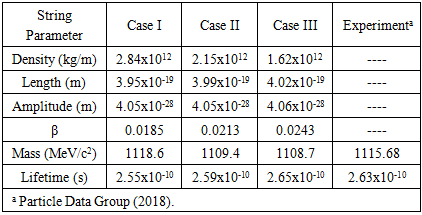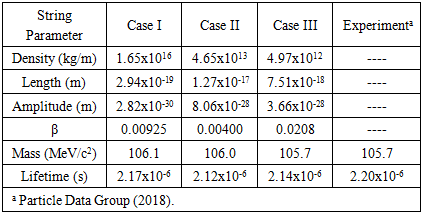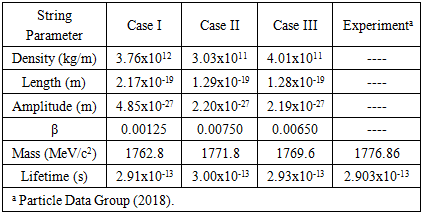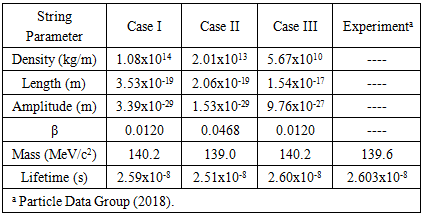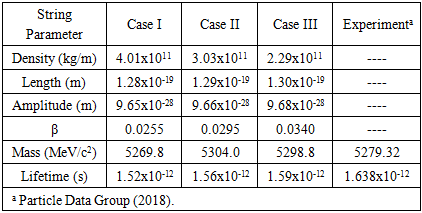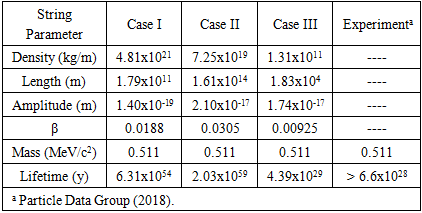-
Paper Information
- Paper Submission
-
Journal Information
- About This Journal
- Editorial Board
- Current Issue
- Archive
- Author Guidelines
- Contact Us
Journal of Nuclear and Particle Physics
p-ISSN: 2167-6895 e-ISSN: 2167-6909
2020; 10(1): 1-8
doi:10.5923/j.jnpp.20201001.01

Nonrelativistic Open String Model Parameters Based on Particle Mass and Lifetime Values
J. J. Bevelacqua
Bevelacqua Resources, 343 Adair Drive, Richland, WA, USA
Correspondence to: J. J. Bevelacqua, Bevelacqua Resources, 343 Adair Drive, Richland, WA, USA.
| Email: |  |
Copyright © 2020 The Author(s). Published by Scientific & Academic Publishing.
This work is licensed under the Creative Commons Attribution International License (CC BY).
http://creativecommons.org/licenses/by/4.0/

Candidate string parameters are investigated using a nonrelativistic open string model with fixed endpoints. String parameters are based on the particle mass and lifetime values of selected baryons, leptons, and mesons. A wide variation in string parameter values is predicted for the baryons, leptons, and mesons considered in this paper.
Keywords: String theory, String parameters, Open string model, and particle decay
Cite this paper: J. J. Bevelacqua, Nonrelativistic Open String Model Parameters Based on Particle Mass and Lifetime Values, Journal of Nuclear and Particle Physics, Vol. 10 No. 1, 2020, pp. 1-8. doi: 10.5923/j.jnpp.20201001.01.
Article Outline
1. Introduction
- String theory is an elegant mathematical formulation [1-7] that has yet to be experimentally verified. Verification would usually include the identification of specific particles and their associated lifetime and mass values. This paper takes a somewhat different approach by utilizing known particle mass and lifetime values to extract specific string parameters including the density, length, amplitude, and velocity. Specific particle parameter values and associated decay modes are uncertain and have been qualitatively discussed [8-27]. Matsunami et al. [27] recently reviewed the decay of cosmic string loops, derived from four linear string segments. This paper [27] also provided possible values for selected string parameters that were previously not specifically quantified. Quantifying these parameters is important if specific string theory predictions are made and compared with available data. Using [27] as a guide, this paper will calculate string parameters for a nonrelativistic open string model with fixed endpoints. The vibrational energy of the string and the observed particle mass and mean lifetime values are used to derive selected string parameters including the density, length, amplitude, and velocity. Selected baryons (i.e., neutron and lambda), leptons (i.e., muon and tau), and mesons (i.e., charged pion and B meson) are specifically used to extract the aforementioned string parameters based on their well defined mass and lifetime values. By constraining the model to reproduce the particle mass and mean lifetime, a set of parameters that provide an initial representation for the string will be derived.Following the calculation of string parameters for the selected particles with well-defined mass and lifetime values, the string parameters and lifetime values of the proton and electron are determined. The proton and electron do not have a specific lifetime value and only a lower bound is experimentally determined [25]. Therefore, the lifetime and string parameters are based solely on the proton and electron masses and the available lifetime bounds. The resulting proton and electron string parameters will be compared to the parameter values for the shorter-lived neutron, lambda, muon, tau, charged pion, and charged B meson. Determination of these string parameters is fraught with obvious uncertainty. The present approach provides string parameters that provide an initial, but not definitive, set as the basis to explore in future work. Subsequent work will include a model string incorporating charge, electric and magnetic fields, multiple interacting strings including loops, various boundary conditions, interaction types, gauge theories, and symmetry conditions. The deviation in string parameters from the base case established in this paper values will illuminate the dependence of the various parameters on specific string properties.
2. Model Overview
- The model proposed in this paper assumes the production of cosmic strings following the big bang or during a big bang/crunch cycle of cosmic events. In this paper, it is assumed that particles result from the emission of the vibrational energy of the string. The fields associated with these particles can be derived from a number symmetry classes.A simple example would be an Abelian-Higgs theory with a complex scalar field and a U(1) gauge field [27]. This class of fields is shown by Matsunami et al. [27] to produce a string with a lifetime, defined in Section 6.0 that is proportional to the square of the string length.Following the Abelian-Higgs field theory with a U(1) gauge approach, the decay of strings into requisite particles occurs episodically with an associated energy loss. In this paper, this energy loss is associated with the particle mass. Accordingly, long-lived particles (e.g., protons and electrons) will have a longer string length than shorter-lived particles (e.g., the neutron and lambda baryon, muon and tau leptons, and the charged pion, and charged B meson). To provide a representative sample of string parameters, a set of baryons, leptons, and mesons are evaluated. The baryons include the neutron (939.6 MeV/c2) and lambda (1115.68 MeV/c2). These baryons were selected to provide a range of mean lifetimes (τ) from the longer-lived neutron (τ ≈ 880.2 s) to the shorter-lived lambda (τ = 2.632x10-10 s). In a similar fashion, the selected leptons include the muon (105.7 MeV/c2) and tau (1776.86 MeV/c2) with a range of lifetimes. The lifetime of the muon and tau are 2.197x10-6 s and 2.903x10-13 s, respectively. The selected mesons include the charged pion (139.6 MeV/c2) and charged B meson (5279.32 MeV/c2). Their mean lifetimes are 2.603x10-8 s and 1.638x10-12 s, respectively.The selected particles provide a range of mass and lifetime values to evaluate the set of derived string parameters. The variation in masses and lifetimes provides a means to consider the string parameters as they depend on mass, particle type, and lifetime.For each particle, the best three fits to the particle mass values are listed in Tables 1 – 6. The lifetime of particles is used as a constraint on the calculation by specifying a range of values around the experimental value. These ranges and their impact on the calculations are illustrated in Tables 1 – 6. The resulting calculations illustrate the range of parameter values that could be applicable to a string description of elementary particles.In addition to the aforementioned baryons, leptons, and mesons, the lifetime of the proton and electron and associated string parameters are determined from their masses and bounding lifetime values. The differences in string parameters for the longer-lived proton and electron and shorter-lived particles summarized in Tables 1 – 6 are addressed in subsequent discussion. The proton and electron results are summarized in Tables 7 and 8, respectively. The proton and electron results only have a lower lifetime bound to constrain the string parameter results. Therefore, it is expected that the results of Table 7 and 8 will have a larger range of lifetime and string parameter values since a rigorous lifetime constraint cannot be imposed.
3. Model Parameter Specification
- The string utilized in this paper is limited to nonrelativistic velocities. The energy of the string available for particle decay is based on its total vibrational energy (kinetic plus potential energy). In this paper, selected baryons, leptons, and mesons are utilized to illustrate the model application and calculation of the associated particle masses, lifetimes, and string parameters. Key model parameters include the string density, which is related to the tension, and the length, amplitude, and velocity. Bounds on the string tension (S), derived from pulsar timing measurements [22-24,27], are based on the gravitational wave background produced by decaying cosmic string loops. This bound,
 , is based on Newton’s gravitational constant (G) and is derived from simulations that ignore the field composition of the string. This would correspond to a string mass density of about 1.4x1017 kg/m. As a matter of comparison, a density of 1.4x1027 kg/m is derived from the Planck energy divided by the Planck length. [20] suggests that a string density of 1021 kg/m is an appropriate string density. This suggests a range of density values is possible. Accordingly, the string density is permitted to vary over a range of values. Matsunami et al. [27] suggest that particle radiation is associated with a string length that is < 10-19 m. Longer lived particles that do not decay or that have extended lifetimes (e.g., protons and electrons) would be expected to have significantly longer string lengths. In addition, cosmological strings are expected to be mildly relativistic [27]. [27] utilizes values of 0.33 c and 0.6 c in their calculations. The model proposed in this paper uses a nonrelativistic approach and limits the string velocity to values less than used in [27].These parameter values will be used as a guide and not a specific limitation in this paper. Reasonable variations will be considered in subsequent discussion. In particular, the density is permitted to vary between 107 and 1.4x1027 kg/m. The string length is permitted to vary within the 10-21 to 1046 m. String velocity is assumed to be nonrelativistic and is limited to
, is based on Newton’s gravitational constant (G) and is derived from simulations that ignore the field composition of the string. This would correspond to a string mass density of about 1.4x1017 kg/m. As a matter of comparison, a density of 1.4x1027 kg/m is derived from the Planck energy divided by the Planck length. [20] suggests that a string density of 1021 kg/m is an appropriate string density. This suggests a range of density values is possible. Accordingly, the string density is permitted to vary over a range of values. Matsunami et al. [27] suggest that particle radiation is associated with a string length that is < 10-19 m. Longer lived particles that do not decay or that have extended lifetimes (e.g., protons and electrons) would be expected to have significantly longer string lengths. In addition, cosmological strings are expected to be mildly relativistic [27]. [27] utilizes values of 0.33 c and 0.6 c in their calculations. The model proposed in this paper uses a nonrelativistic approach and limits the string velocity to values less than used in [27].These parameter values will be used as a guide and not a specific limitation in this paper. Reasonable variations will be considered in subsequent discussion. In particular, the density is permitted to vary between 107 and 1.4x1027 kg/m. The string length is permitted to vary within the 10-21 to 1046 m. String velocity is assumed to be nonrelativistic and is limited to  The amplitude is restricted to be less than the string length.
The amplitude is restricted to be less than the string length.4. Base Case String Model
- Cosmic strings have extremely large masses that greatly exceed the particle masses considered in this paper. The particle masses are assumed to be generated by the kinetic and potential energies of the vibrating string. The resulting particle mass does not depend on the total inclusive string mass. In this paper, the inherent string mass is treated as a renormalized vacuum or zero point energy with particles associated with the vibrational energy of the string.As a base case, a one-dimensional string of finite length and fixed endpoints is assumed to vibrate with peak amplitude A
 | (1) |
 is the displacement of the string from its linear, nonoscillating state, k is the wave number, x is the position as measured from one end of the string, ω is the angular frequency, and t is the time. The string is assumed to be under tension and has mass per unit length
is the displacement of the string from its linear, nonoscillating state, k is the wave number, x is the position as measured from one end of the string, ω is the angular frequency, and t is the time. The string is assumed to be under tension and has mass per unit length  and is fixed at x=0 and x=L where L is the nonvibrating string length. For small displacements, summing the kinetic and potential energies determines the amount of energy contained within a segment of length dx.The kinetic energy (dT) is the product of the string segment’s mass and its velocity
and is fixed at x=0 and x=L where L is the nonvibrating string length. For small displacements, summing the kinetic and potential energies determines the amount of energy contained within a segment of length dx.The kinetic energy (dT) is the product of the string segment’s mass and its velocity | (2) |
 | (3) |
 | (4) |
 due to the tension
due to the tension | (5) |
 | (6) |
 and
and  yields
yields | (7) |
 | (8) |
 | (9) |
 is
is | (10) |
 | (11) |
 | (12) |
5. Particle Mass
- In order to estimate the characteristics of a string corresponding to a particle’s mass, a simplifying assumption is made (i.e., the string is vibrating in its fundamental frequency). This is a reasonable first approximation because the selected particles are not a resonance of a lighter particle.An application of Eq. 12 permits an estimate of particle’s rest mass energy
 This can be accomplished using the relationship between angular frequency and frequency
This can be accomplished using the relationship between angular frequency and frequency 
 | (13) |
 | (14) |
 | (15) |
6. Particle Lifetime
- Matsunami et al. [27] provide a relationship for the string lifetime

 | (16) |
 is the number of episodes per period, and
is the number of episodes per period, and  is the average energy lost per unit time which the model assumes to be the rest mass energy. The string described in Section 4 is used as the basis for estimating the particle lifetime.The particle lifetime is derived by assuming the following:1. The model, defined in Sections 2 – 4, specifies the string parameters that characterize the particle.2. One episode per period is assumed which is consistent with the fundamental mode assumption of Section 5.3. The average energy lost per unit time (e.g., over a period) is the string kinetic plus potential energy. Since the string is nonrelativistic, this is assumed to be the particle’s rest mass. The particle lifetime is derived from the rest mass energy of the particle
is the average energy lost per unit time which the model assumes to be the rest mass energy. The string described in Section 4 is used as the basis for estimating the particle lifetime.The particle lifetime is derived by assuming the following:1. The model, defined in Sections 2 – 4, specifies the string parameters that characterize the particle.2. One episode per period is assumed which is consistent with the fundamental mode assumption of Section 5.3. The average energy lost per unit time (e.g., over a period) is the string kinetic plus potential energy. Since the string is nonrelativistic, this is assumed to be the particle’s rest mass. The particle lifetime is derived from the rest mass energy of the particle  and is defined by Eqs. 15 and 16.4. Only the string kinetic plus potential energy contributes to the particle mass. The inherent string mass
and is defined by Eqs. 15 and 16.4. Only the string kinetic plus potential energy contributes to the particle mass. The inherent string mass  is essentially a constant (i.e., it is the vacuum or zero point energy), because the particle energy is much smaller than this inherent mass.
is essentially a constant (i.e., it is the vacuum or zero point energy), because the particle energy is much smaller than this inherent mass.7. Results and Discussion – Particles with Defined Mass and Lifetime
- The model results provide specific values for the evaluated particle masses and lifetimes. Model results for the selected baryons, leptons, and mesons suggest that credible mass and lifetime values can be obtained for a range of string parameters. The string parameters supporting these values are each addressed, their variation with particle mass and lifetime are discussed in subsequent commentary, and are included in Tables 1, 2, 3, 4, 5, and 6 for the neutron, lambda, muon, tau, charged pion, and charged B meson, respectively. The three best fits to the particle mass and the associated lifetime are provided in these tables.
|
|
|
|
|
|
|
|
7.1. Particle Masses
- The particle masses summarized in Tables 1 – 6 are within 1% of the experimental values for all cases summarized in these tables. Neutron and lambda mass errors, summarized in Tables 1 and 2, are as large as 0.39% and 0.63%, respectively. For the leptons summarized in Tables 3 and 4, the maximum muon and tau mass errors are 0.46% and 0.79%, respectively. The charged pion and charged B meson maximum mass errors of Tables 5 and 6 are 0.44% and 0.47%, respectively. These results are expected to be reasonably accurate because the solutions with the smallest mass error values are provided in Tables 1 - 6. An additional constraint of reproducing a reasonable lifetime value is included in the process of obtaining the most accurate particle mass. The lifetime values are addressed in the next section.
7.2. Particle Lifetime
- Following Eq. 16 and the associated discussion, the particle lifetime values are strongly dependent on the string length, tension, and particle mass. The particle mass (Eq. 15) involves multiple parameters, but the lifetime (Eq. 16) only depends on a subset of these parameters. Therefore, it is expected that the lifetime errors will be larger than the mass errors. This is observed in the calculations with lifetime values within 8% of the experimental values versus a mass error of less than 1%.For baryons, the maximum neutron and lambda lifetime errors are 1.6% and 3.0%, respectively. The muon and tau lepton maximum lifetime values are 3.6% and 3.3% respectively. Similar maximum lifetime errors are noted for mesons. The maximum lifetime errors for the charged pion and B meson are 3.6% and 7.2%, respectively.Given the simplistic nonrelativistic, uncharged, fixed endpoint open string model, the mass and lifetime results are encouraging. However, the model parameter assumptions and associated parameter ranges are still lacking in experimental verification.
7.3. String Density
- As noted in Tables 1 and 2, there is significant variation in the neutron and lambda string density for the best fits to the particle mass and associated lifetime constraint. The largest string density occurs for the neutron (1012 to 1018 kg/m) and a significantly smaller density is predicted for the lambda (≈1012 kg/m). For these baryons, a higher neutron string density corresponds to a longer lifetime. However, higher string densities do not correspond to higher particle mass values. For the leptons summarized in Tables 3 and 4, there is somewhat less variation in the string density than for baryons. Muons have a larger string density (1012 to 1016 kg/m) than tau leptons (1011 to 1012 kg/m). The lepton string density varies with particle mass and lifetime in a manner that is similar to the baryon variation.The meson string density has a similar relationship to particle mass and lifetime that was noted for baryons and leptons. As summarized in Tables 5 and 6, charged pions have a larger string density (1011 to 1014 kg/m) than charged B mesons ((≈1011 kg/m).
7.4. String Length
- Following [27], the string length associated with decay of unstable particles should be <10-19 m. As noted in previous discussion, this value provides an indication of an expected string length and the results of the open string nonrelativistic model may differ.For baryons, the neutron and lambda string lengths are in the range of 10-15 to 10-12 m and ≈10-19 m, respectively. A similar range of string values is found for leptons. The muon and tau string lengths are in the range of 10-19 to 10-17 m and ≈10-19 m, respectively. The meson values are 10-19 to 10-17 m and ≈10-19 m for the charged pion and B meson, respectively. For the baryons, leptons, and mesons summarized in Tables 1 – 6, larger string lengths are associated with smaller masses and longer lifetimes.These values are larger than the predictions of [27]. However, the open string model results are encouraging given the simplicity of the present approach. In addition, the similarity of the values is suggestive that the model is providing a reasonable first approximation to the physical values. As noted in Tables 7 and 8, larger string lengths are associated with increased particle stability. This result is consistent with the approach of Ref. 1.
7.5. String Amplitude
- There is no obvious relationship between the amplitude and other string parameters for the baryons considered in Tables 1 and 2. The neutron amplitude is in the range of 10-29 to 10-25 m, and the heavier lambda amplitude is ≈10-28 m. For leptons and mesons, larger amplitude values suggest a larger mass and shorter lifetime. The muon amplitude is in the range of 10-30 to 10-27 m, and the heavier tau has an amplitude of ≈10-27 m. Meson amplitudes follow a similar pattern, but the differences are not as large. The charged pion amplitude is in the range of 10-29 to 10-26 m, and the heavier charged B meson has a value of ≈10-27 m.
7.6. String Velocity
- The string velocity is restricted to β ≤ 0.05. An examination of Tables 1 – 6 suggests that there is no general velocity relationship between values of β and the particle mass or mean lifetime and associated string parameters.
8. Results and Discussion – Protons and Electrons
- The Section 7 results were based on particles with known masses and lifetimes. These results provided a set of string parameters that were summarized in Tables 1 – 6. Given these results, the methodology is extended to stable particles with defined masses, but only lower bounds established for their lifetimes [25]. By constraining the proton and electron with their physical masses and lower lifetime bounds, string parameters are obtained which determine the model’s prediction of the particle lifetime.Since the proton and electron do not have a definitive lifetime, their string parameters are likely to vary more than the Table 1 – 6 values because the lifetime constraint cannot be rigorously imposed. The particles summarized in Tables 1 – 6 have defined lifetime values, and therefore have a more constrained set of string parameters.
8.1. Particle Masses
- The proton and electron masses have a smaller error than the baryons, leptons, and mesons summarized in Tables 1 – 6. Maximum mass errors for the proton and electron are 1.3x10-4 % and 7.6x10-5 %, respectively.A more accurate mass representation is expected for protons and electrons because only a lower bound for their lifetime is experimentally known. With a less restrictive lifetime criterion, a more accurate proton and electron mass calculation is expected.
8.2. Particle Lifetimes
- Protons and electrons do not have definitive mean lifetime values, but [25] only provides lower bounds. The proton results summarized in Table 7 suggests a range of mean lifetime values (1037 – 1058 y) that is larger than the current experimental estimate of >2.1x1029 y. Calculated electron lifetimes, summarized in Table 8, of 1029 – 1059 y are also larger than the current experimental estimate of >6.6x1028 y. The calculated lifetimes exhibit a rage of values. Given the nature of the model, the predicted values do not represent a definitive characterization of the actual proton and electron lifetimes. However, the model lifetimes do suggest that the physical lifetime values for both the proton and electron could be larger than the current experimental lower bounds.
8.3. String Density
- The string density values summarized in Tables 7 and 8 for the proton and electron are in the range of 1010 – 1027 kg/m and 1011 – 1021 kg/m, respectively. Given the wide range of values, there is no definitive correspondence to the values provided in Tables 1 – 6. The string density values summarized in Tables 1 – 6 overlap the proton and electron values of Tables 7 and 8. However, the largest proton and electron values exceed the string density values summarized in Tables 1 – 6.
8.4. String Length
- The proton and electron string lengths are orders of magnitude larger than the baryon, lepton, and meson values summarized in Table 1 – 6. Proton and electron string lengths are in the range of 106 to 1011 m and 104 to 1014 m, respectively. Eq.16 suggests that larger proton and electron lifetime values should correspond with string lengths that are much larger than the Tables 1 - 6 values. This assertion is noted in Tables 7 and 8. As outlined in previous discussion, the model is not expected to provide definitive string length values. However, the results of Tables 1 – 6 are entirely consistent with the results of [27]. The particles with shorter mean lifetimes tend to have shorter string lengths. Although noted in [27], the interpretation for string lengths longer than the Table 1 – 6 values implies that the gravitational interaction dominates. This can be interpreted to describe a string that is stable with respect to particle decay. The proton and electron lifetimes predicted by the model are consistent with long-lived stable particles and with their experimental lifetime values.
8.5. String Amplitude
- The proton and electron amplitude values are in the range of 10-20 to 10-13 m and 10-19 to 10-17 m, respectively. These ranges are on average larger than the values provided in Tables 1 – 6. There is no obvious correlation of the amplitude value with respect to particle mass. Larger amplitude values correspond with the longer lifetimes of the proton and electron. However, given the number of parameters involved in the description of particle masses and lifetimes, no definitive conclusions can be drawn regarding the amplitude and its relationship with the mass and lifetime values summarized in Tables 1 – 8.
8.6. String Velocity
- The string velocity of protons and electrons are not markedly different than the velocity values summarized in Tables 1 – 6. There are no definitive conclusions that can be drawn with respect to the string velocity of protons and electrons, summarized in Tables 7 and 8, and the other string parameters or particle masses and lifetimes. A similar result was noted for the baryons, leptons, and mesons summarized in Tables 1 – 6.
9. Generalization to Closed String Models
- Bagchi et al. [26] note that there is a natural emergence of an open string from a closed string given selected parameter limits. There is also a condensation of perturbative closed string modes to an open string. [26] provides an important calculation that has the potential to generalize the open string model of this paper to closed string models.
10. Conclusions
- The proposed nonrelativistic open string model with fixed endpoints provides an initial set of string parameters that yield reasonable masses and mean lifetime values for the neutron, lambda, muon, tau, charged pion, and charged B meson. Lifetime values and string parameters are also derived for the proton and electron. The proton and electron lifetime values exceed their current lower bound experimental estimates. The derived parameters and lifetime values for the neutron, lambda, muon, tau, charged pion, charged B meson, proton, and electron are based on a simplistic open string model, and will likely change as the model becomes more complex through the inclusion of charge, electric and magnetic fields, multiple strings with loops, additional boundary conditions, and specific symmetries and gauge theories. The validity of the proposed and subsequent models will be determined by experimental verification. Experimental verification is ultimately the requirement that will determine the validity of all string theories. However, this initial set of parameters provides a base case for future investigation, development, and determination of observable string characteristics.
 Abstract
Abstract Reference
Reference Full-Text PDF
Full-Text PDF Full-text HTML
Full-text HTML
